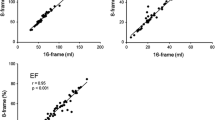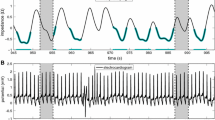Abstract
Introduction and background
The polarity status is one of the important items of specifications of trigger signal from cardiac trigger monitors with two options, either positive or negative. Some systems allow the user to set the polarity of trigger signal before imaging. Efforts should be made to set the polarity status according to the recommendations provided by the manufacturers. In case of inappropriate selection, changes in computation of end-systolic and end-diastolic volumes as well as ejection fraction may occur.
Objective
To investigate the effect of the polarity status of trigger signals in synchronization process during 8- and 16-frame gated SPECT imaging on the systolic and diastolic parameters of LV function.
Methods
Thirty-four patients referred for a myocardial perfusion SPECT were consecutively included in the study. The rest scan for each patient was performed with 8- and 16-frame gating simultaneously with positive trigger signal set by the operator in a cardiac trigger monitor and then repeated after manual selection of negative polarity. In total, the 4 imaging modes acquired were 8-frame/positive-trigger, 16-frame/positive-trigger, 8-frame/negative-trigger, and 16-frame/negative-trigger. All SPECT images were reconstructed and processed with the same values of parameters. Systolic and diastolic indices of LV function were derived in QGS of the Cedars-Sinai software and then were compared using various statistical tests, and a reliability analysis was also performed.
Results
The age of patients recruited in the study was 58.41 ± 8.94, and 16 (47.1%) males and 18 (52.9%) females. All the correlation coefficients between corresponding parameters in positive and negative trigger signals were statistically significant. The difference between the parameters of systolic function including EF, EDV, and ESV in positive and negative trigger signals was statistically significant in paired sample t test. Likewise, a statistically significant difference was also found between mean phase angle in scans with positive and negative trigger signals by a phase difference of 147.91 (41.0% of an average cardiac cycle) and 149 (41.3% of an average cardiac cycle) degrees in 8- and 16-frame gating modes, respectively. Strong agreement (according to high values of intra-class correlation coefficient) was found for all four pairs. According to Bland-Altman results, an offset of about 3 percentage units was found, both between imaging in 8-frame gating compared to 16-frame gating, higher value in favor of 16-frame gating, and also between imaging with positive polarity trigger compared to negative-polarity trigger, again higher value in favor of positive-polarity triggering.
Conclusion
The status of the polarity of trigger signals or similar CTM-camera delays in synchronization process during 8- and 16-frame gated SPECT imaging can be considered as one of the factors that may influence systolic and diastolic indices of LV function





Similar content being viewed by others
Abbreviations
- EF:
-
Ejection fraction
- EDV:
-
End-diastolic volume
- ESV:
-
End-systolic volume
- ED:
-
End diastole
- ES:
-
End systole
- CTM:
-
Cardiac trigger monitor
- PER:
-
Peak ejection rate
- PFR:
-
Peak filling rate
- TTPF:
-
Time to peak filling rate
- ICC:
-
Intra-class correlation coefficient
References
Lang O, Trojanova H, Balon HR, Kunikova I, Bilwachs M, Penicka M, et al. Pulse wave as an alternate signal for data synchronization during gated myocardial perfusion SPECT imaging. Clin Nucl Med 2011;36:762-6.
Sievers B, Wiesner M, Kiria N, Speiser U, Schoen S, Strasser RH. Influence of the trigger technique on ventricular function measurements using 3-Tesla magnetic resonance imaging: Comparison of ECG versus pulse wave triggering. Acta Radiol 2011;52:385-92.
Kording F, Schoennagel B, Lund G, Ueberle F, Jung C, Adam G, et al. Doppler ultrasound compared with electrocardiogram and pulse oximetry cardiac triggering: A pilot study. Magn Reson Med 2015;74:1257-65.
Bailey DL, Kalemis A. Externally triggered gating of nuclear medicine acquisitions: A useful method for partitioning data. Phys Med Biol 2005;50:N55-62.
Qutbi M. Technical aspects and errors of triggering and synchronization in gated single photon emission computed tomography myocardial perfusion imaging. Indian J Nucl Med 2020;35:154-9.
Holly TA, Abbott BG, Al-Mallah M, Calnon DA, Cohen MC, DiFilippo FP, et al. Single photon-emission computed tomography. J Nucl Cardiol 2010;17:941-73.
Corbett JR, Akinboboye OO, Bacharach SL, Borer JS, Botvinick EH, DePuey EG, et al. Equilibrium radionuclide angiocardiography. J Nucl Cardiol 2006;13:e56-79.
Ivy Biomedical Systems, Inc. Model 3000 series cardiac trigger monitor—Operation manual. Ivy Biomedical Systems, Inc.; 2010. http://www.ivybiomedical.com/pdf/3000%20OM%20English.pdf. Accessed 11 March 2021.
Ivy Biomedical Systems, Inc. Model 7600 series cardiac trigger monitor—Operation manual. Ivy Biomedical Systems, Inc.; November 2015. https://pdf.medicalexpo.com/pdf/ivy-biomedical-systems-inc/model-7600/100610-133918.html. Accessed 11 March 2021.
Djaballah W, Muller MA, Bertrand AC, Marie PY, Chalon B, Djaballah K, et al. Gated SPECT assessment of left ventricular function is sensitive to small patient motions and to low rates of triggering errors: A comparison with equilibrium radionuclide angiography. J Nucl Cardiol 2005;12:78-85.
Shufelt C, Hachamovitch R. Statistical analysis of medical data. Part II. J Nucl Cardiol 2000;7:263-6.
Morgan CJ, Aban I. Methods for evaluating the agreement between diagnostic tests. J Nucl Cardiol 2016;23:511-3.
Abidov A, Germano G, Hachamovitch R, Berman DS. Gated SPECT in assessment of regional and global left ventricular function: Major tool of modern nuclear imaging. J Nucl Cardiol 2006;13:261-79.
Garcia EV, Slomka P, Moody JB, Germano G, Ficaro EP, Instructions CME. Quantitative clinical nuclear cardiology: Part 1—Established applications. J Nucl Cardiol 2020;27:186-8.
Kim DW, Park SA, Kim CG. Gating error because of prominent T waves with ECG-gated myocardial SPECT. Clin Nucl Med 2008;33:278-9.
Ahmadi R, Qutbi M. Profound gating error and flattened time–volume curve from inefficient triggering from improper setting of ECG leads in myocardial perfusion SPECT. J Nucl Cardiol 2021. https://doi.org/10.1007/s12350-021-02615-9.
Wackers FJ. Has LVEF changed beyond chance? Limits of agreement of radiotracer-derived LVEF. J Nucl Cardiol 2015;22:1244-6.
Kim SJ, Kim IJ, Kim YS, Kim YK, Shin YB, Kim DS. Automatic quantification of right ventricular volumes and right ventricular ejection fraction with gated blood pool SPECT: Comparison of 8- and 16-frame gated blood pool SPECT with first-pass radionuclide angiography. J Nucl Cardiol 2005;12:553-9.
Montelatici G, Sciagra R, Passeri A, Dona M, Pupi A. Is 16-frame really superior to 8-frame gated SPECT for the assessment of left ventricular volumes and ejection fraction? Comparison of two simultaneously acquired gated SPECT studies. Eur J Nucl Med Mol Imaging 2008;35:2059-65.
Navare SM, Wackers FJ, Liu YH. Comparison of 16-frame and 8-frame gated SPECT imaging for determination of left ventricular volumes and ejection fraction. Eur J Nucl Med Mol Imaging 2003;30:1330-7.
Ansari M, Hashemi H, Soltanshahi M, Qutbi M, Azizmohammadi Z, Tabeie F, et al. Factors that impact evaluation of left ventricular systolic parameters in myocardial perfusion gated SPECT with 16 frame and 8 frame acquisition models. Mol Imaging Radionucl Ther 2018;27:55-60.
Author information
Authors and Affiliations
Corresponding author
Ethics declarations
Disclosure
All the authors of this article declare that they have no conflict of interest.
Additional information
Publisher's Note
Springer Nature remains neutral with regard to jurisdictional claims in published maps and institutional affiliations.
The authors have also provided an audio summary of the article, which is available to download as ESM, or to listen to via the JNC/ASNC Podcast.
All editorial decisions for this article, including selection of reviewers and the final decision, were made by guest editor Saurabh Malhotra, MD, MPH.
Supplementary Information
Below is the link to the electronic supplementary material.
Rights and permissions
About this article
Cite this article
Qutbi, M., Soltanshahi, M., FarokhiMoghadam, F. et al. Polarity status of trigger signal during ECG-gating affects parameters of LV function in gated myocardial perfusion SPECT. J. Nucl. Cardiol. 29, 2199–2209 (2022). https://doi.org/10.1007/s12350-021-02675-x
Received:
Accepted:
Published:
Issue Date:
DOI: https://doi.org/10.1007/s12350-021-02675-x




